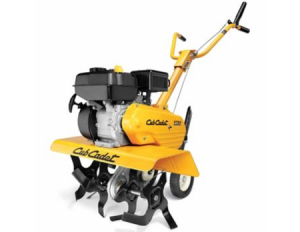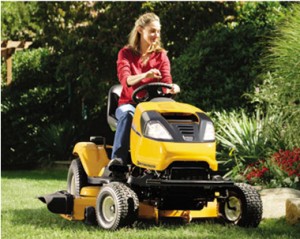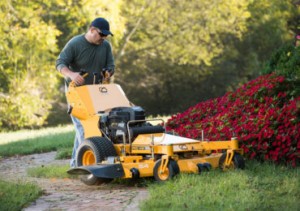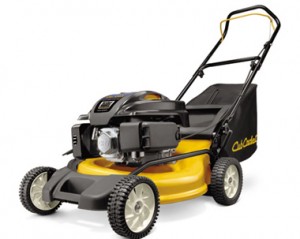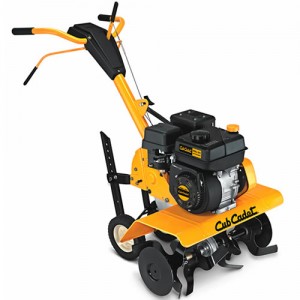Stamped or constructed deck? Carburetor or EFI? A narrow deck for maneuverability or a wide deck for speed? No matter what you need from a lawn tractor, you can get it with the XT2. Built to handle rougher terrain than the XT1 line, these mowers can tackle large lawns and are compatible with a long list of attachments, making them useful year-round.
Decks
The XT2 is offered with decks in 42, 46, 50 and 54-inch widths that have a cutting height range of one to four inches. Most models come with a stamped deck. Forming the deck out of a single sheet of steel lets it take on a rounded shape that hugs the blades, providing maximum vacuum for the best finish.
The LX 46” EFI uses a fabricated deck. By welding steel plates together, this forms a deck that’s better at withstanding impacts, but its boxy shape reduces vacuum. Cub Cadet adds internal baffles to improve performance, but this deck won’t get the finish of their stamped decks.
Engines
Cub Cadet offers these tractors with a choice of two engines: the Kohler 7000 and the company’s own EFI V-Twin.
Kohler’s 7000 series is a residential engine based on their commercial Command Pro line. The automatic Smart-Choke helps the engine start at any temperatures, while the Consistent-Cut governor reacts swiftly to changing load demands to keep the blades from slowing down when moving into taller grass.
Cub Cadet’s 679cc EFI V-Twin is the first consumer fuel injected small engine on the market, bringing significant improvements in operating cost, performance and maintenance requirements. It uses 25% less fuel than carbureted engines and doesn’t have the issues with aging fuel. That means there’s no need to use fuel stabilizer during the mowing season, while remaining fuel can be treated and left in the tank during storage. It will even run on E15, further reducing fuel costs. Electronic control also delivers faster governor response for the best cutting performance.
Making Maintenance Easier
All XT2 mowers use the QuickAttach system. Both the decks and attachments are designed to be installed and removed without tools, making it easy to switch jobs or perform repairs.
Two of the XT2 models come with Cub Cadet’s new FastAttach blade system, which uses a locking collar to hold the blade in place. The blades can be installed and removed without tools, and since there are no bolts, there’s no need to check torque settings.
Models
Each version of the XT2 is named after its deck size. Here’s the equipment, engine and deck design you’ll get with each model:
LX42”
22 hp Kohler 7000
Stamped Deck
LX46”
24hp Kohler 7000
Stamped Deck
LX46” EFI
Cub Cadet EFI
Fabricated deck
SLX50”
FastAttach blade system
679cc Cub Cadet EFI
Stamped deck with nose roller
SLX50” KH
24 hp Kohler 7000
Stamped deck with nose roller
SLX54″
25 hp Kohler 7000
Stamped deck with FastAttach blade system
This mower comes with Cub Connect. Using your smartphone, you can connect to the hour meter via Bluetooth. From there, the Cub Connect app helps you keep track of maintenance and access information specific to your model including specifications and maintenance instructions.
GX54″ D
26 hp Kohler 7000
Fabricated deck
This model is designed for maximum performance when using accessories. It comes with a differential lock for increased traction, and it’s the only model in the XT2 lineup that works with ground-engaging attachments.
Accessories
Mulching kits are available for all decks. These add high lift blades and a discharge plug to cut clippings into small pieces that fertilize the lawn. Bagging kits are also available to collect clippings.
Cub Connect can be used with any model by adding a Bluetooth-enabled hour meter.
These mowers can also be useful in the winter thanks to a 42-inch three stage snowthrower, while the 42-inch dozer blade is useful for moving snow and dirt.
Need weather protection? The XT2 can be fitted with a sunshade or combination sunshade and snow cab. Need to protect your mower from front impacts? Add a front brush guard.
Cub Cadet makes compatible trailers with utility and dump beds as well as broadcast spreaders for overseeding and fertilizing. The rear cargo tray attaches to the trailer hitch, adding a little extra on-board storage.
Warranty
The chassis, deck shell, and front axle have a limited lifetime warranty, the chassis and front axle are guaranteed for 5 years, and the rest of the XT2 and Cub Cadet EFI engine are guaranteed for three years. Kohler offers their own three-year warranty on the 7000 Series.
Get the Most from Your Cub Cadet Mower
Cubparts.com is a certified dealer for Cub Cadet and Kohler, letting us offer OEM parts and accessories for everything on your mower. Our site has built-in parts diagrams and uses factory descriptions, making it easy to find what you need for your equipment. We ship across the U.S. and Canada.


